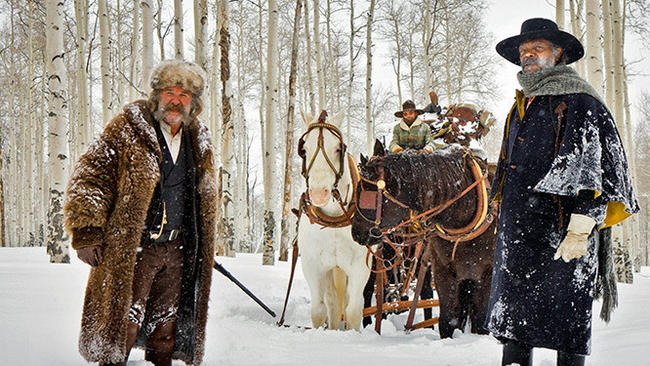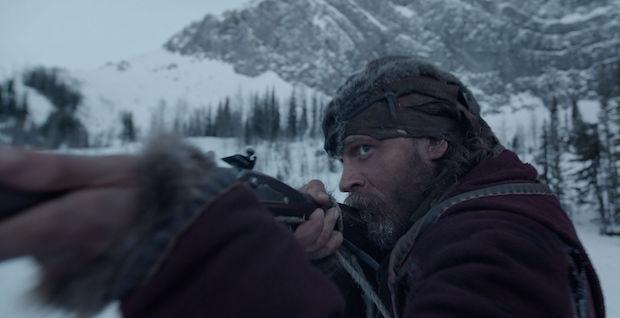The Hateful Eight

As a storyteller Quentin Tarantino is a cold-hearted chess player. He sets up his characters on the board and then pits them against each other in violent combat, gazing unflinchingly at the resulting carnage, uncaring and unmoved. This clinical approach seemed to be slipping slightly in Tarantino’s 2012 film Django Unchained, in which he seemed to truly care for a couple of the characters he sent into the fray, but its back with a vengeance in The Hateful Eight, which is undoubtedly his most sadistic and amoral film to date. That’s not to say the film doesn’t have its redeeming features, but you have to dig through a couple of inches of gore to find them.
The film opens with a wooden crucifix displaying Christ contorted with pain on the cross. Perhaps its just Gothic set dressing, but my guess is it has more significance–its warning us that we’re about to see some of the horrific evils Christ came to die for. The story unfolds as eight shifty characters hole up in a haberdashery to wait out a blizzard. The Civil War has just ended and soldiers who fought on both sides are present. There’s a black Union soldier turned bounty hunter with a history or ruthless killing under his belt, as well as two former Confederates guilty of similar atrocities. A second bounty hunter has a ruthless female killer chained to his wrist who he’s taking into town to hang, and the rest of the shifty company may or may not be who they claim.
As the film unfolds, characters shift around the large single room of the haberdashery, discussing the nature of justice and arguing the finer points of war and race. No one is clean–everyone has blood on their hands–but Tarantino picks a side early on. Soon cataclysmic violence erupts and plot twists start coming fast and loose. By the film’s end two of the more sympathetic characters have formed an unlikely alliance, overlooking their vast differences in an attempt to survive. It’s a strangely sweet note in an otherwise sour work, and the only redeeming aspect of the story. For all the hatefulness and violence on screen, this film is actually really well made; I just really didn’t like watching it.
The Revenant

I should love The Revenant–it has everything I love in it: great actors, realistic period art design, a beautiful and hypnotic score, and stunning natural light cinematography by one of my favorite cinematographers–but I really don’t care for the thing. The film is based on the true life story of trapper Hugh Glass, who was mauled by a bear and abandoned in the American wilderness only to eventually catch up with the men who left him for dead. It’s a great story but unfortunately Director Alejandro González Iñárritu makes all the wrong revisionist choices, adding extra levels of violence and conflict to an already thrilling tale and tacking on an unnecessary revenge plot that makes the film more of a big dumb historical action flick like The Patriot than the deep art film it so desperately wants to be.
There are some great moments in The Revenant, moments that transcend the film and thrill with their beauty, but these are few and far between and are muddied by an overabundance of fake looking CG-enhanced action scenes, an overbearing blue color palette, unnecessarily fancy camera work and a complete lack of spacial reasoning, which makes one question the implied difficulty of Glass’s journey. He basically wanders around and bumps into whichever character or group of characters he needs to meet next, and we cut from mountains to rivers to plains to frozen lakes without any sort of visual coherence.
The film ends with a fight scene of unearned brutality and a statement that so overly simplifies what we’ve just seen that I want to reach into the screen and slap the character who says it. I’m not sure why The Revenant has garnered such praise from critics or so many Oscar nominations. It feels more like a missed opportunity than a great work.
